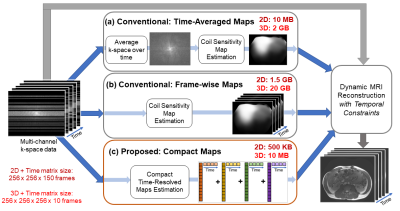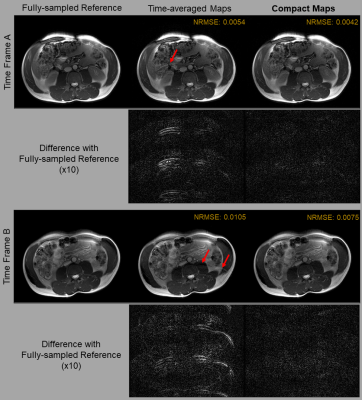Shreya Ramachandran1, Frank Ong2, and Michael Lustig1
1Electrical Engineering and Computer Sciences, University of California, Berkeley, Berkeley, CA, United States, 2Electrical Engineering, Stanford University, Stanford, CA, United States
1Electrical Engineering and Computer Sciences, University of California, Berkeley, Berkeley, CA, United States, 2Electrical Engineering, Stanford University, Stanford, CA, United States
We present a method that solves for a compact representation of time-resolved coil sensitivity maps to dramatically reduce their size in memory (by ~1000x). Our Compact Maps result in decreased calibration error and improved reconstruction quality when compared to time-averaged maps.

Figure 2. Overview of Compact Maps in a dynamic MRI reconstruction pipeline. Maps are generally pre-computed for reconstructions with temporal constraints, not computed on-the-fly. Conventionally, maps are estimated (a) from time-averaged k-space data or (b) individually for each time frame, then stored in the spatial domain. (c) Instead, Compact Maps are linear combinations of temporal basis components. Memory estimates are for $$$N$$$=4 basis components, 24x24 map kernel size, 8 channels, and the listed matrix size. We see ~1000x savings in memory with Compact Maps over (b).

Figure 5. Comparison of image reconstruction quality using time-averaged maps and Compact Maps. Reconstruction has been performed for both time frames A and B using iterative SENSE with l2 regularization of λ=0.001. Difference images (x10) with the fully sampled reference are also shown. Residual aliasing artifacts are visible in images reconstructed with time-averaged maps (red arrows) and in the magnitude difference images, but are mitigated when using Compact Maps. Normalized root-mean square error (NRMSE) is also reduced in the images reconstructed using Compact Maps.
